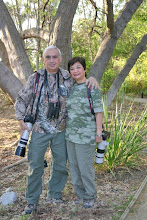March 6, 2018 - Early in the morning our guide, Rene, took us to the "Insect light" area. Within the vicinity of the lodge, there was a trail leading to the forest. Along this trail, the owners set up a shed where they put a lamp that was lit all night to attract insects. Early in the morning, they turn off the lamp. That's when different kinds of birds come to feed on the insects that remained.
It was still dark when we arrived. We saw an amazing number of birds. Taking pictures of them, however, was a real challenge. One of the negative aspects of the Tamron lens I was using was it was not good at focusing on dark subjects. Despite using a very high ISO, the results still were blurred. Cynthia's 300mm Canon lens performed just a tad better. At least some of the photos she got were good enough for us to be able to claim two species as lifers. Lifer #9 was a White-breasted Wood Wren.
The other was a really bad shot of a Golden-crowned Warbler.
After about an hour, we returned to the lodge to have breakfast. That was when we added our eleventh lifer - the Chiriqui Quail-Dove.
After a hearty breakfast, Rene drove us to the Tuis River where he assured us we will find the Sunbittern. While waiting for our target bird to show up, we finally were able to get good photos of the Passerini's Tanager.
Looking over the river was an Amazon Kingfisher.
Were also lucky to get another lifer here: The Grey-capped Flycatcher.
Rene was a bit flustered since his assurance didn't seem to be panning out as expected. He asked a local lady who was feeding her cow in a pen if she had seen the Sunbittern. She nonchalantly pointed at something inside the cow pen. Rene laughed and showed the "rare" bird to us. Eventually, the Sunbittern got out of the dung-filled pen and casually strolled along the roadside, unmindful of two excited bird photographers. A really unexpected but amusing way to encounter our lifer #13. Unfortunately, we were not able to get a photo of it with its wings wide open - the image all bird photographers hoped to get.
Having accomplished his mission, our guide asked us if we wanted to see more. "How about a Boat-billed Heron?" he asked. Although we've seen this species two years ago in Panama, we weren't able to get any picture at all because it was too far and was hidden among tall grasses. So we gladly accepted his offer. About a half hour later, we entered the CATIE (Center for Tropical Agricultural Research and Education - {in Spanish}) Botanical Park. Rene parked near a lagoon and pointed to our 14th lifer - the Northern Jacana.
Then in a clump of bamboo trees, several species in the Ardeidae family were perched: Great Egret, Cattle Egret, Black-crowned Night Heron and as promised, the Boat-billed Heron. This time it was out in the open and close enough for us to get the desired photos.
As we toured the park, we picked up a couple more lifers:
Number 15 - Groove-billed Ani
Number 16 - Yellow-bellied Elaenia
Lunchtime and we were back at the lodge. That afternoon we racked up four more lifers just in front of the dining area of Rancho Naturalista. Two kinds of Motmots and two kinds of Hummingbirds.
Number 17 - Lesson's Motmot
Number 18 - Rufous Motmot
Number 19 - Crowned Woodnymph
Number 20 - Violet Sabrewing
It was another fruitful day of birding for us.
This evening’s walk
1 day ago


















No comments:
Post a Comment